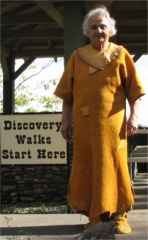THEY LOOKED FORWARD TO
THE GREAT COLUMBIA
Meriwether Lewis and William Clark
and Naomi was there 200 years later
| Sacajawea State Park is where the event took place and where the Lewis & Clark Corps of Discovery landed October 16, 1805. I led the Discovery Walks to explain the landing and how the terrain looked to white men who had only dreamed of seeing the Great Columbia River. Across the water is the far side of the great river but not as the Corps saw it. |  |
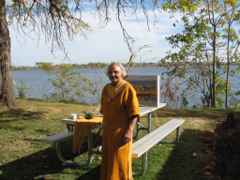 |
Naomi in her elkskin garment stood on the bank of the Snake River in Sacajawea Washington State Park and described the terrain 200 years ago. The water now backed up by the McNary dam located south on the Columbia River where it turns to flow west between Washington and Oregon. Across the water is the present Walla Walla county side of the Snake. |
| Thorny brush as shown and sagebrush, gray and green rabbitbrush, and antelope bitterbrush dotted the landscape. There were no trees "as far as the eye extends" complained Ordway in his journal. The desert hills and sandy shoreline were beautiful to their eyes, nonetheless. The Snake 200 years ago was only 475 yards wide at this point and the landing is under the water some twenty feet beyond the bank of Sacajawea park. | 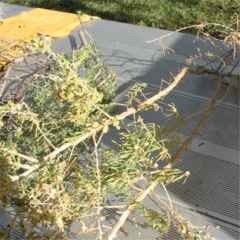 |
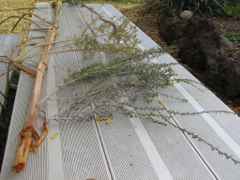 |
Visitors were curious enough and touched and smelled of the samples. The rabbitbrush was in bloom with a brilliant yellow along the road as they drove into the park. Sage brush is also in bloom but the blossoms are so tiny they give the bushes a yellowish tinge if in full flower. Other plants used by the native peoples were cattail for food, choke cherry and Osier dogwood for arrow and spear shafts. |
| Prickly pear cactus was described in the journals as "terrible" as it must have been considering how the spines would stick through the buckskin mocassins and fester in the feet of the men. A visitor asked if Lewis knew the cactus was edible and of course he did but to send out men to pick the small plant and clean it for eating was asking far too much of mighty hunters. | 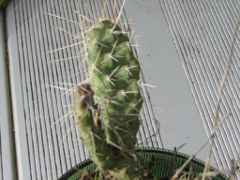 |
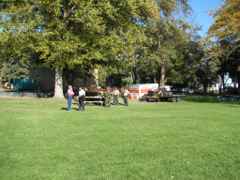 |
Looking at the trees and grass of the park, visitors found it difficult to imagine the Corps landed in desert. Daughters of Washington Pioneers in 1946 worked to transform the desert into a state park. Being loyal daughters, they insisted the name should be Sacajawea after the young Shoshone woman who stuck with Lewis & Clark all the way from North Dakota. |
| Many trees planted in 1946 are still growing although some have been ravaged by insects and the hard southwest winds over the years. | 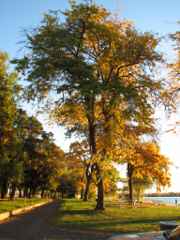 |
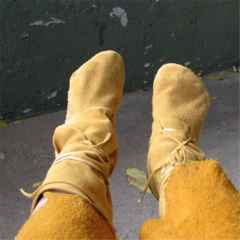 |
These deerskin mocassins didn't keep the modern gravel from hurting dainty white feet. I shudder at the thought of stepping on cactus thorns. Barbs on the spines worked into the flesh and made for sore blistered feet many miles along the Snake river as the Corps made its last few miles to the Columbia River. My footsteps were limited to the tarmack of the walk and the soft manicured lawn along the bank. |
| Visitors came for the Discovery Walk on Saturday and Sunday. On Friday and Monday school children were bused in for hands-on science and to meet re-enactors of the expedition. | 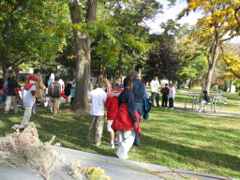 |
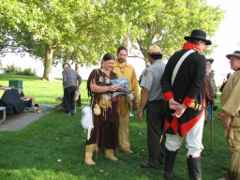 |
Red headed Captain Clark portrayed by a school teacher looks exactly like I pictured the man in size and stature. He was on hand to answer questions and explain his tools used to map the expedition. Other actors played parts of the Corps and talked with visitors as well. |
| Sargent Patrick Gass was a carpenter and wrote a journal that was published before any other documentation of the trip. The player is the Park Ranger of the Lewis and Clark State park near Dayton, Washington. | 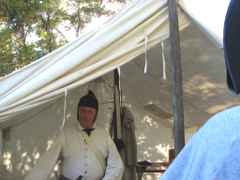 |
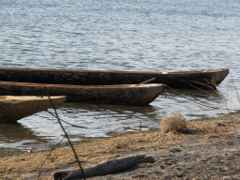 |
The landing was re-enacted on the swimming beach on the Columbia river because there was no beach on the Snake. The Corps arrived in dugout canoes that were pulled up on the sand for people to examine. They were made by tools replicated from the Corps records and dug out by a group still making them for sale. |
| A Shoshone woman appeared as Sacajawea with such a life-like doll cradled on her bosom that children touched it with reverence. | 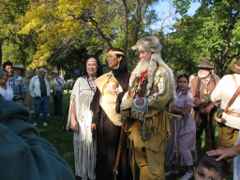 |
